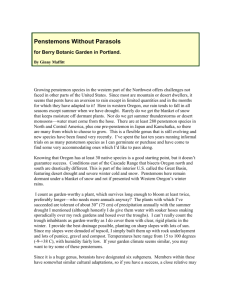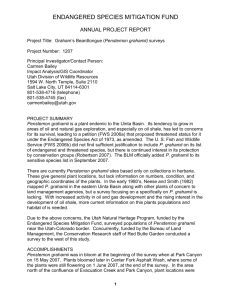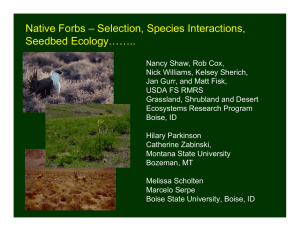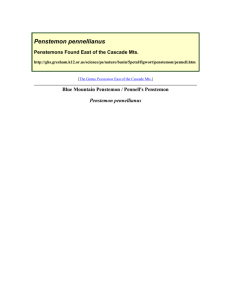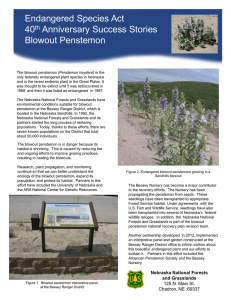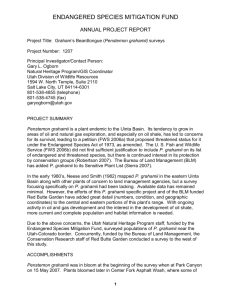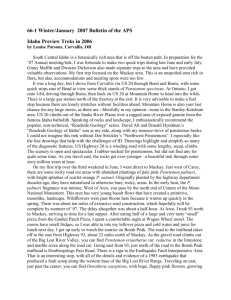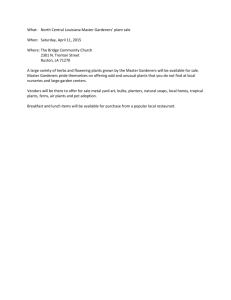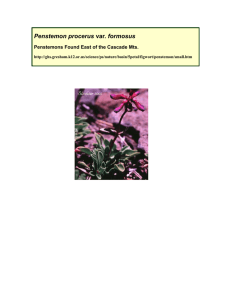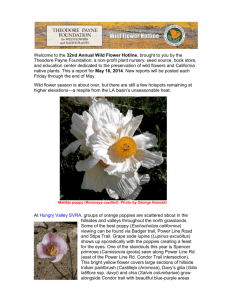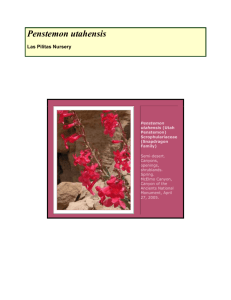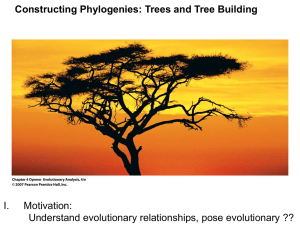Interbreeding
advertisement
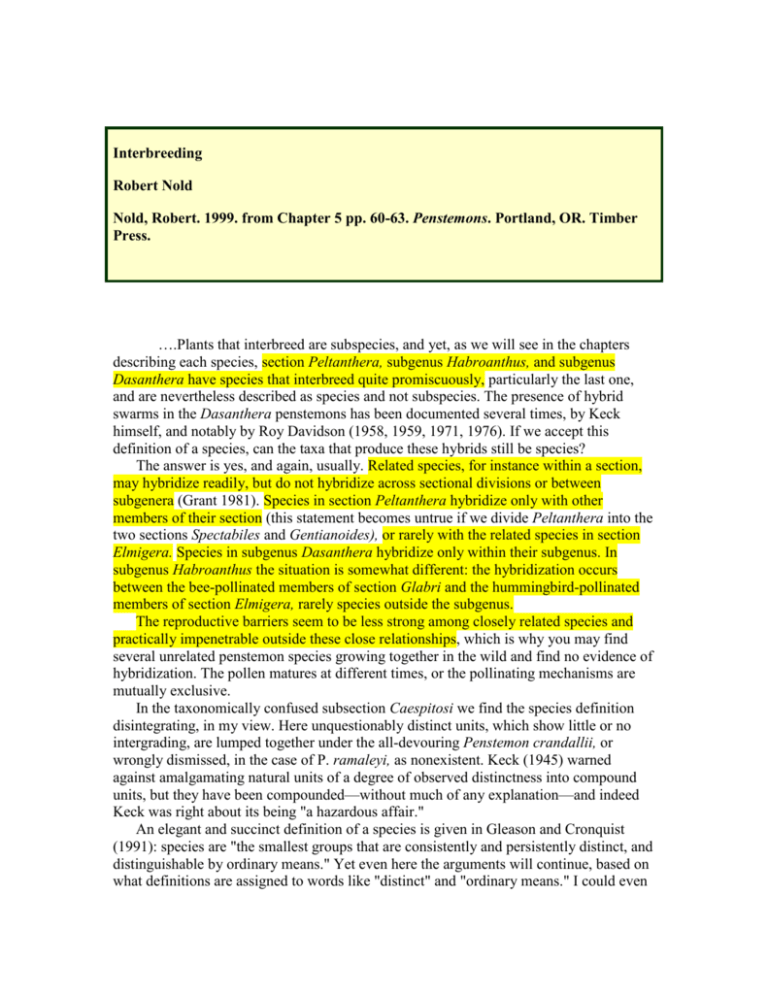
Interbreeding
Robert Nold
Nold, Robert. 1999. from Chapter 5 pp. 60-63. Penstemons. Portland, OR. Timber
Press.
….Plants that interbreed are subspecies, and yet, as we will see in the chapters
describing each species, section Peltanthera, subgenus Habroanthus, and subgenus
Dasanthera have species that interbreed quite promiscuously, particularly the last one,
and are nevertheless described as species and not subspecies. The presence of hybrid
swarms in the Dasanthera penstemons has been documented several times, by Keck
himself, and notably by Roy Davidson (1958, 1959, 1971, 1976). If we accept this
definition of a species, can the taxa that produce these hybrids still be species?
The answer is yes, and again, usually. Related species, for instance within a section,
may hybridize readily, but do not hybridize across sectional divisions or between
subgenera (Grant 1981). Species in section Peltanthera hybridize only with other
members of their section (this statement becomes untrue if we divide Peltanthera into the
two sections Spectabiles and Gentianoides), or rarely with the related species in section
Elmigera. Species in subgenus Dasanthera hybridize only within their subgenus. In
subgenus Habroanthus the situation is somewhat different: the hybridization occurs
between the bee-pollinated members of section Glabri and the hummingbird-pollinated
members of section Elmigera, rarely species outside the subgenus.
The reproductive barriers seem to be less strong among closely related species and
practically impenetrable outside these close relationships, which is why you may find
several unrelated penstemon species growing together in the wild and find no evidence of
hybridization. The pollen matures at different times, or the pollinating mechanisms are
mutually exclusive.
In the taxonomically confused subsection Caespitosi we find the species definition
disintegrating, in my view. Here unquestionably distinct units, which show little or no
intergrading, are lumped together under the all-devouring Penstemon crandallii, or
wrongly dismissed, in the case of P. ramaleyi, as nonexistent. Keck (1945) warned
against amalgamating natural units of a degree of observed distinctness into compound
units, but they have been compounded—without much of any explanation—and indeed
Keck was right about its being "a hazardous affair."
An elegant and succinct definition of a species is given in Gleason and Cronquist
(1991): species are "the smallest groups that are consistently and persistently distinct, and
distinguishable by ordinary means." Yet even here the arguments will continue, based on
what definitions are assigned to words like "distinct" and "ordinary means." I could even
2
see some arguing over the meaning of every word in this simplest of definitions.
When a plant is a hybrid (the result of a cross between two recognizable species) and
when it is an example of "transition" is a different story. The presence of hybrids at the
point of contact between two related but morphologically distinct species is an accepted
fact. When a new plant can be described as having the flowers of one species carried on
the herbage of the another, or flowers shaped like one species but in the color of another,
or a variety of other possible combinations, hybridization has occurred and the status of
the species is retained.
Evidence of transition demotes a species to the rank of variety ("variety" is currently
preferred to "subspecies"). Say that you had one "species" with glabrous, linear leaves,
and a nearby "species" with pubescent, obovate leaves, surrounded by specimens with
leaves that were intermediate in width and pubescence; then, whichever species was
described more recently would be demoted to varietal level—a case of first come, first
served. This type of rearrangement has occurred dozens of times in Penstemon.
It might be argued that examples of transition are in fact examples of
hybridization; surely, some "transitional" samples would appear to be hybrids, and the
fact of discontinuity just a peculiarity of geography. For instance, we would expect
hybridization at the point where two species literally come into contact if the species are
interfertile, but is that colony two miles away only an example of "transition" and not of
hybridization? I do not know the answer to this question (and wish I had never raised it);
it is best to state that some species hybridize and some species have transitional elements
that used to be called separate species.
Many species, when found in the wild, will not necessarily have all the characteristics
ascribed to them in every instance. Gardeners and wildflower enthusiasts who believe, as
the noted maverick botanist E. L. Greene did, that species are immutable and that only
plants exactly matching the type description can be considered the true species will be
disappointed in penstemons. Penstemon species are variable. The type specimen for a
particular species may only represent a group of aggregates in the species' spectrum, and
those at opposite ends of the spectrum may be quite different in some respects. In some
instances, only comparison with another, different species will show the true
characteristics of each in an understandable way.
Gardeners and horticulturists tend to be suspicious of botanists (the reverse is
probably true, too) when it comes to plant names. No sooner have the plant labels been
printed than the name has been changed and the labels are now wrong. The incessant
name-changing that transforms old friends into sudden strangers can be discouraging to
gardeners who want to grow a recommended plant, only to find that what they have been
growing and cherishing for many seasons has been traveling under an assumed name.
This is just a fact of life in horticulture, but as I see it, less of a burden than some
gardeners think it is. New knowledge, if it tells us more about the plants we love, is
always worth the inconvenience.
Names are also changed because the ones in use are shown to be invalid. One
example of this is the change from Penstemon bridgesii, Bridges's penstemon, to the
older name, P. rostriflorus. The species has been properly described by Kellogg as P.
rostriflorus in 1860, and by Gray, apparently unaware of the earlier description, in 1868,
as P. bridgesii. This is a case where gardeners and horticulturists who resist change
should make an exception and use the correct name of P. rostriflorus.
3
Invalid names are an unfortunate fact of penstemon taxonomy, especially where
sectional names are concerned. It is so unfortunate that I am retaining some of them even
though I realize they are invalid, simply because the valid prior names have species
homonyms in unrelated sections.
In some instances the names are never accepted. Some of this has to do with an
individual botanist's concept of a species, and some of it is simply due to the lack of
overall focus in the genus; in the absence of a definitive monograph to use as reference,
names are omitted, obscured, or considered synonyms without further investigation. The
segregation of eleven species into the new genera Keckiella, Nothochelone, and
Pennellianthus, discussed in Chapter 8, is not universally accepted, either; the genera
seem to be upheld by authorities working within Penstemon but are often ignored by
those working in a more general field.
Another reason for name changes is not so much taxonomical arcana as it is the
impenetrably mysterious world of horticulture: plants are identified incorrectly, and the
misidentification is passed on, via plant labels, through generations of gardeners, garden
writers, and nurseries. This is understandable. Few people have the time to try to key out
plants, and penstemons certainly seem to be a mass of confused names and look-alike
species (or varieties). Fictitious creations are the result, names such as "Penstemon
caespitosus 'Claude Barr'," "P. newbenyi subsp. roezlii," "P. menziesii" (which besides
being an invalid synonym for P. davidsonii var. menziesii also refers, for unknown
reasons, to the bedding penstemons), and "P. xgloxinioides" (any, it would seem, uprightgrowing hybrid).
Species with selected color variants are described as cultivars {Penstemon cardwellii
'Albus'), not as invalid Latin trinomials (P. cardwellii albus]. As far as common names
go, penstemons have few of them; the name "beardtongue" is sometimes applied to the
genus as a whole. I have tried to note as many as seem legitimate and have refrained from
the currently fashionable but unhelpful (and irritating) practice of making up my own. I
have translated the Latin specific names in hopes that they will be thus easier to
understand, except for those named after people, in which case they may be simply
translated as, for example, P. hallii = Hall's penstemon.
Personal Communication from Ginny Maffitt
…hybridization usually occurs between members of a section or subgenus, so that's why
members of Dasanthera growing near each other are considered to be producing hybrid
seed. Check p. 60 of Bob Nold's "Penstemon" book for this discussion. One exception
he mentions is in subgenus Habroanthus, where members of section Glabri and Elmigera
will cross, as one if bee and the other hummingbird pollinated.
Collectors considering 2 species in bloom could check to see if they're closely related by
looking them up in most penstemon texts. An easier way is to collect from an isolated
plant (other side of the house?).
